Homemade deodorant that really works… is it even possible? Yes! With Bentonite clay for sensitive skin, this natural deodorant recipe fights body odor, absorbs excess moisture, and soothes irritation without toxic ingredients!
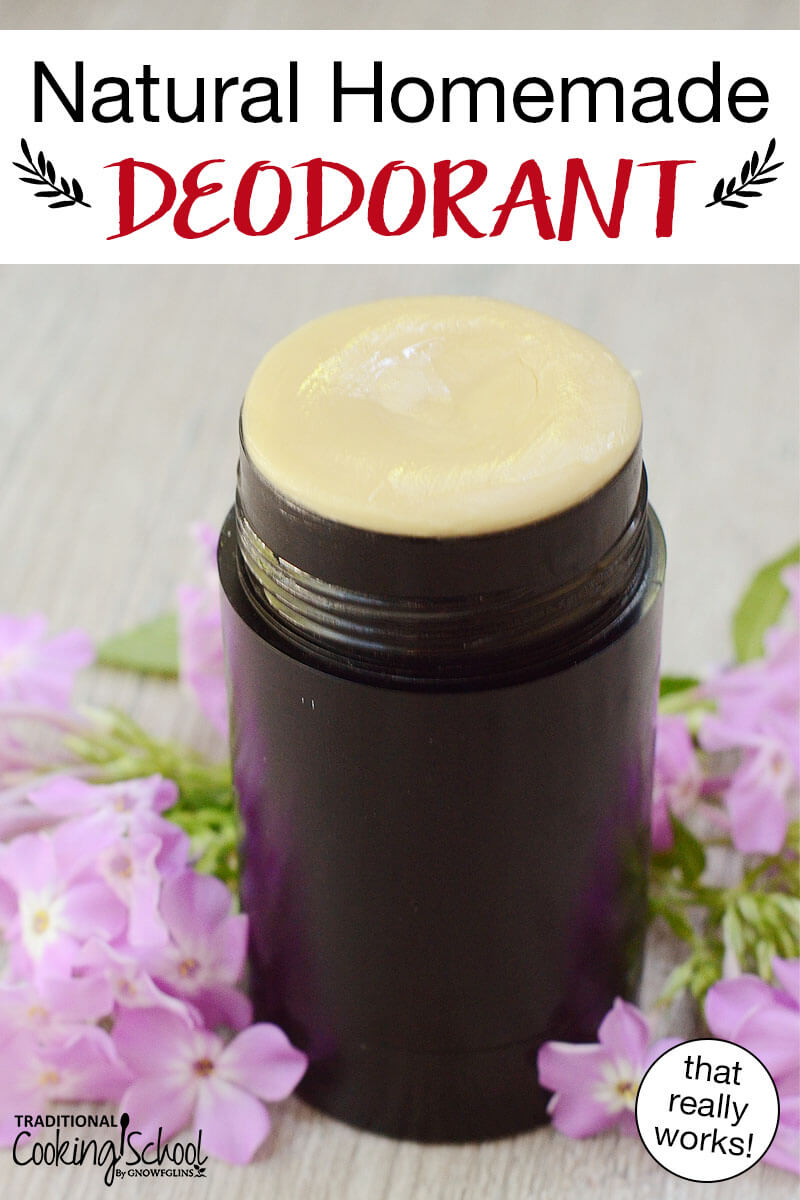
How does homemade deodorant compare to commercial products?
- It’s frugal.
- It contains natural ingredients that you can know and trust.
- And, it’s versatile! Tweak it to suit your family’s unique needs.
When it comes to making homemade deodorant, the golden rule is: try, try again!
If you’ve ever tried natural deodorant, whether homemade or store-bought, you likely know that many simply don’t work. This is incredibly frustrating when you’ve spent time and money on ingredients or shopping for store-bought versions.
However, it is possible to find a natural deodorant that works! It just takes some time.
And it is most definitely a worthwhile endeavor as conventional deodorant is full of harmful ingredients linked to Alzheimer’s and other neurodegenerative diseases, as well as cancer (source, source, and source).
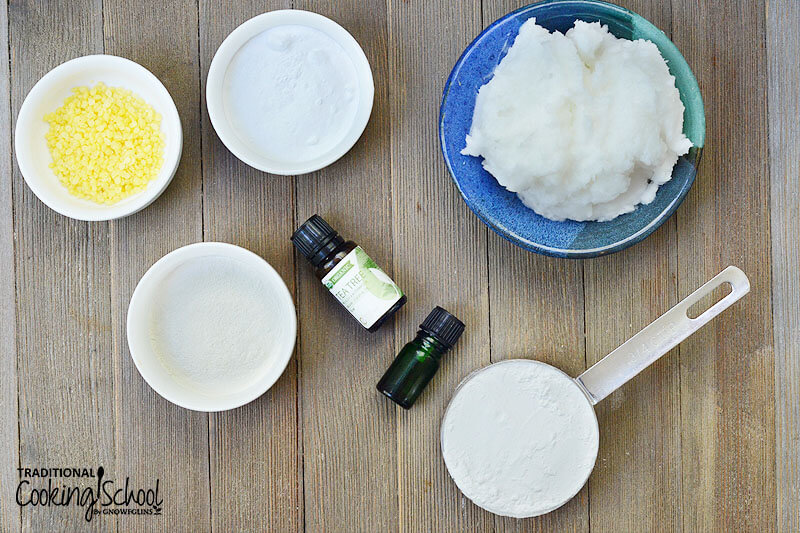
Table Of Contents
Natural Ingredients
As with all personal care products, natural ingredients are of utmost importance. After all, what we put on our bodies is just as important as the food we eat.
When it comes to natural deodorant recipes, there are a few common ingredients you’ll find in most recipes in varying amounts.
- Baking Soda
- Arrowroot Powder
- Coconut Oil
- Shea Butter
- Cocoa Butter
- Beeswax
- Bentonite Clay
- Essential Oils
Let’s take a look at each of them below and discuss why they are used.
Baking Soda
A star ingredient in most recipes, baking soda is used to absorb and eliminate odor. Baking soda can be irritating to some and has been known to cause redness in the armpits of those with sensitive skin.
That said, it is often not the baking soda itself, but the amount of baking soda that is used. Many find that using less baking soda and balancing it with soothing ingredients puts an end to the problem.
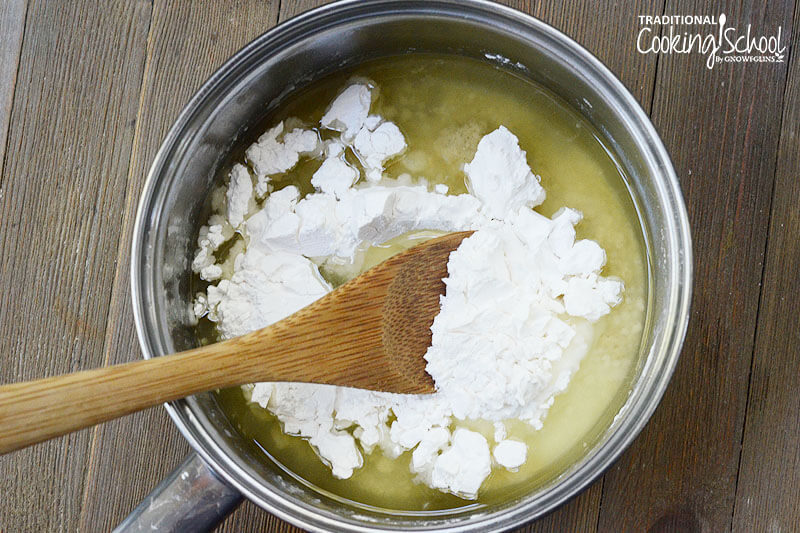
Arrowroot Powder
Often hailed as the healthier version of cornstarch, arrowroot helps absorb excess moisture.
Coconut Oil
Coconut oil is solid at room temperature and aids in providing bulk to homemade deodorant. It also brings antibacterial properties, which may aid in warding off bacteria that causes odor.
Finally, coconut oil is nourishing, moisturizing to the skin, and helps create a spreadable formula.
Shea Butter
This emollient butter is usually added for its moisturizing qualities. Shea butter melts on contact with the skin and is very effective is softening and soothing dry patches.
This butter aids in creating a creamy texture. In fact, coconut oil and shea butter are a winning combination for deodorant that is moisturizing and feels good on the skin.
Cocoa Butter
Some natural deodorant recipes use cocoa butter, but it is a less common ingredient. Cocoa butter does bring a nice chocolate scent and can help provide a thicken and firmer consistency.
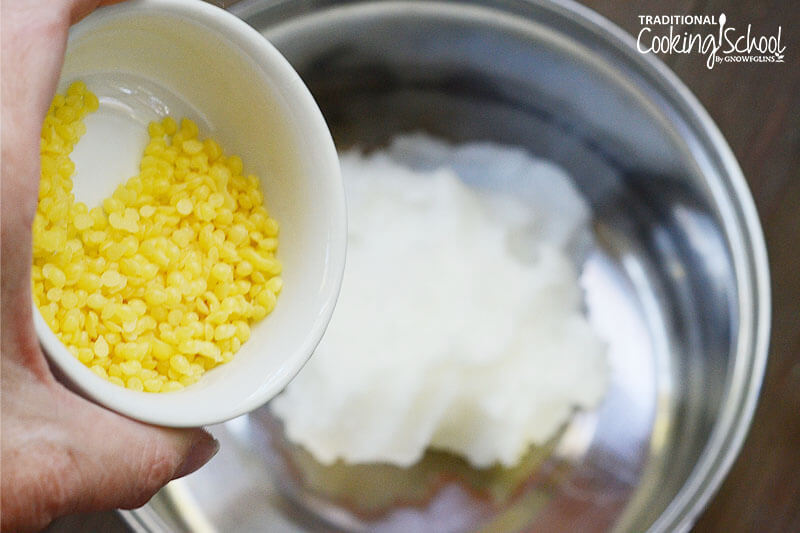
Beeswax
This natural wax is produced by honey bees and is most commonly used in homemade cosmetics as a thickener. The thickening qualities of beeswax are used in homemade deodorant recipes to hold the ingredients together and provide a semi-solid to solid consistency.
Bentonite Clay
This powerful clay is detoxifying in nature and aids in absorbing odor, moisture, and toxins. It is also soothing to the skin.
Bentonite clay is helpful for combating any irritation caused by baking soda.
Essential Oils
Essential oils provide scent and are a great way to customize homemade deodorant. If you want a deodorant that smells amazing, you’ll need to include essential oils.
Besides making your deodorant smell great, essential oils also bring unique benefits and can help prevent odor and bacteria as well as soothe skin.
Wardee’s recipe uses tea tree essential oil and lemongrass essential oil. Both of these provide an uplifting scent and aid in reducing odor-causing bacteria.
Optional Ingredients
Some of the above ingredients could be considered optional, depending on your goals. In general, baking soda, arrowroot, coconut oil, and beeswax are necessary, but essential oils, butters, and clay are optional.
Even though clay may be considered optional, it is highly recommended for its ability to reduce moisture and combat toxins.
Butters, such as shea butter and cocoa butter, are added in smaller amounts and can often be omitted if desired. That said, leaving these out of any recipe will alter the consistency of the end product.
Essential oils can also be left out or substituted. Omitting them can be helpful if you are sensitive to scents, although they do bring some antibacterial benefits, which will be missed if not included.
However, not having essential oils on hand when you wish to make natural deodorant should not deter you from giving it a try.
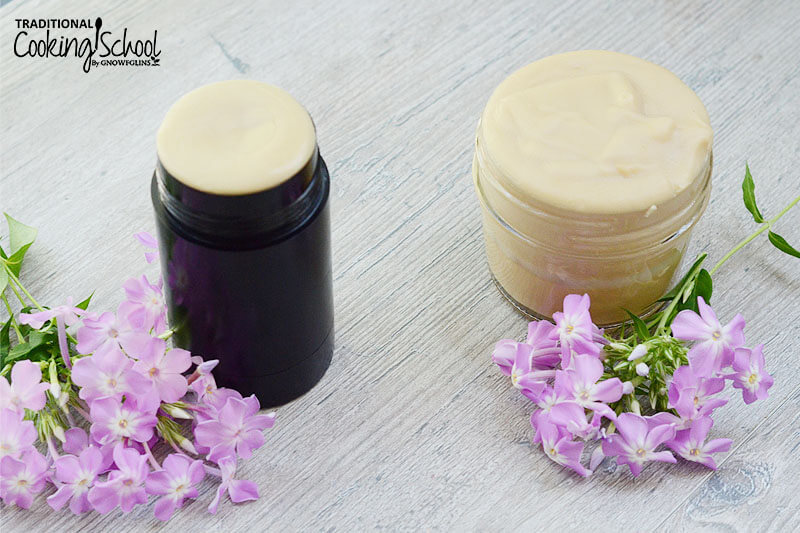
My Quest To Find Natural Deodorant That Works
It took a while for me to find the deodorant that worked for my family. It may take some time for you to find the perfect match for your body chemistry and needs as well.
Because it can take some time, I wanted to show you the process of making and evaluating a number of different recipes to find a natural deodorant that would work well for my family.
I experimented with two recipes from other bloggers and then tried making my own natural homemade deodorant. After trying each of them (my husband used them too!), I evaluated each recipe in terms of its effectiveness, texture, and scent.
Also, we used them on warm, active days so we could really give each deodorant a run for its money. 😉
Natural Deodorant Attempt #1
The first recipe I tried is from Passionate Homemaking. It calls for coconut oil, baking soda, arrowroot powder, and optional tea tree essential oil.
Out of all the recipes I tried, it was the easiest to make. We also enjoyed the scent, as it works well for both men and women.
It had the thickest texture when finished. As the coconut oil changes states with the temperature, it gets a little lumpy and needs some stirring.
Unfortunately, it required two applications a day to be effective… which is why I went back to the drawing board!
Natural Deodorant Attempt #2
The second recipe came from Wellness Mama, differing only slightly from Passionate Homemaking’s deodorant. It calls for coconut oil, shea butter, baking soda, arrowroot powder, and optional essential oils.
This made a lightly golden brown deodorant. I loved the added moisturizing effect from the shea butter!
It required only one application a day but wasn’t quite as effective as I would have liked. It is a little thinner than the other recipes, so I ended up using a little more at a time.
This recipe did not even make 1 cup of deodorant, so in the future I would double this recipe.
Making My Own Natural Deodorant… Attempt #3
Finally, in an effort to find a homemade deodorant that truly met all of my family’s needs, I made up on my own recipe. It took a few tries.
What was my problem? Baking soda.
On my first try, I combined equal amounts of baking soda and arrowroot powder (1/2 cup each).
While the deodorant worked like a charm, the baking soda irritated some family members. It created red painful welts with repeated use and arm movement.
So then I eliminated the baking soda completely and doubled the arrowroot powder to 1 cup. That deodorant didn’t irritate at all, but it didn’t work very well, either. (Think stink.)
Finally, I tried what you see below: 1/4 cup baking soda and 3/4 cup arrowroot powder (plus clay for absorbency and odor control).
Now we have a deodorant that works well and doesn’t irritate anyone. It’s a winner!
(Edit: I have now been using this deodorant for 3 years!)
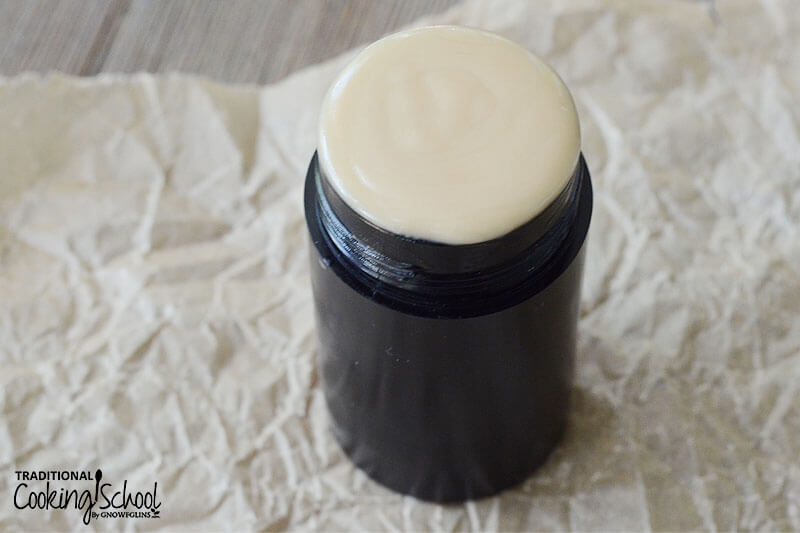
Natural Homemade Deodorant Recipe
The ingredients in this deodorant recipe combine to create a deodorant that is antibacterial and soothing to skin. It includes tea tree and lemongrass essential oils which provide a refreshing scent that is well suited to men and women.
While it is not baking soda-free, this recipe uses much less baking soda than most. This helps prevent irritation, while still providing enough baking soda to eliminate odor.
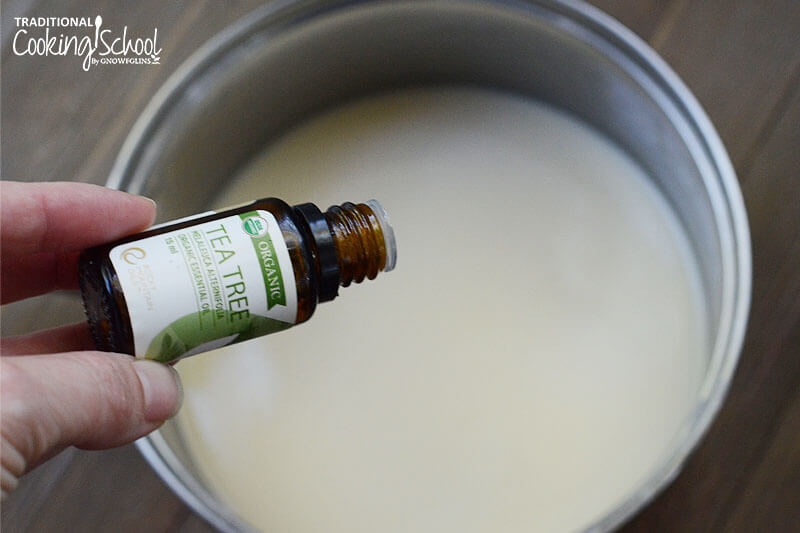
Why This Recipe Works
We love this recipe! It’s very effective — even after a very busy, active day in the heat, we still need only one application to prevent body odor.
I love the quality of the ingredients! Also, the healing benefits of the clay help avoid underarm bumps and rashes.
This homemade deodorant recipe works well for a number of reasons:
- Clay is soothing to skin and counteracts any possible irritation. It also helps absorb moisture and toxins which may cause odor.
- The amount of baking soda in this recipe is enough to be effective in warding off odor, but not so much that it causes redness or irritation.
- Arrowroot effectively absorbs excess moisture.
- Tea tree and lemongrass essential oils help fight odor-causing bacteria.
A Final Experiment: The Stain Test
I took a white cotton onesie and applied a liberal stripe of deodorant across it (more than most would typically apply under their arms).
After giving it about two hours to “set”, I washed and dried the onesie on the normal wash setting without using a stain remover.
There was only a very slight mark, likely due to the clay in the recipe. This most likely won’t show up at all on light-colored clothing.
However, if you’re concerned about staining, use a little less clay or more coconut oil to “thin” the mixture. Or, apply a small amount of natural stain remover prior to washing clothing.
The mark was so faint, though, that I wouldn’t have noticed it without looking for it. Because most people usually wouldn’t have such a high volume of deodorant on their shirt anyway, I wouldn’t “sweat” it at all (pun intended). 🙂
Homemade Deodorant Tips and Tricks
A few notes for successful DIY deodorant:
Summer weather. The deodorant is like soup in the summer, whether in a jar or in a tube. I tried doubling the beeswax and that does help if the temp is just warmer but not really hot.
Here’s what you can do in very hot weather.
- Keep your tube of deodorant in the fridge. While it’s firm but just a little softened from rubbing it on your body, twist the deodorant up to the level you’ll need it next time, then put it back in the fridge. (Right out of the fridge it’s hard to twist up.)
- Or, keep your deodorant in a jar and apply with fingers. You might notice a little separation of coconut oil settling on top; just stir that in with your fingers, then scoop some out and apply to the underarms. I actually prefer applying with my fingers rather than a stick — because I can rub it in well and I find better odor and moisture benefits.
So just play with it and don’t let summer weather prevent you from using and loving natural deodorant.
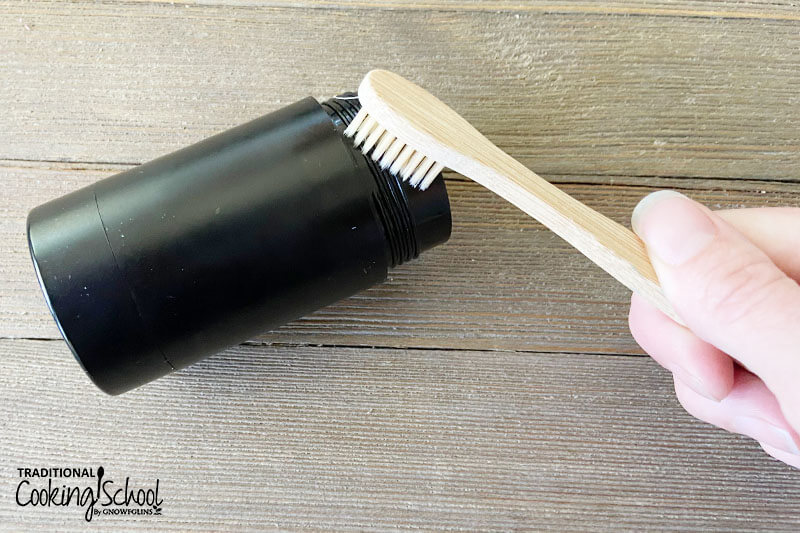
Reusing store-bought deodorant tubes. It’s not the easiest thing to get chemical deodorant out of containers — that junk definitely repels moisture and doesn’t want to come out!
However, a basin of soapy water for soaking and an old toothbrush does a pretty good job. Once you’ve got clean containers you can reuse them again and again. And again.
An old toothbrush can be helpful in removing leftover reside in cracks and crevices, too. Use a little lemon essential oil to help remove stickers or residue on the outside of the container.
Big batches. You can triple or quadruple this batch. Store what you don’t use in a jar in a cool, dark cupboard.
Remelt over a simmering water bath and refill tubes as needed. It’s a big time saver!
Homemade Deodorant FAQs
I’m allergic to coconut oil, what can I use instead? Can I make deodorant without coconut oil?
If you are allergic to coconut oil, give babassu oil a try. It has a very similar consistency to coconut oil and works well as a 1:1 swap in most homemade personal care recipes.
Homemade deodorant gives me a rash. What should I do?
If you are getting a rash, it’s likely due to using too much baking soda, and in some cases, essential oil. Try reducing the amount of baking soda and see how it goes.
If you have not tried homemade deodorant with clay, definitely give that a try. Most people will not get a rash using the recipe above, unless allergic or sensitive to one of the ingredients.
To avoid irritation, it’s also important not to apply directly after shaving. The baking soda and essential oils could sting and lead to a rash when applied to the armpits right after a shave.
Homemade deodorant doesn’t work! I still smell! Help!
There is an adjustment period when switching to natural deodorant. When coming off chemical deodorants, you might find natural doesn’t work for you right away.
Give your body time to adjust. It can take few weeks.
You can help this along by applying a Bentonite clay mask to the armpits a few times each week to aid in detoxification.
My deodorant gets too soft in the summer. How do I prevent this?
Coconut oil-based deodorants can get soft in summer months due to the fact that coconut oil melts at 78 degrees Fahrenheit. Keep it in a cool location to avoid this issue and/or experiment with increasing the amount of beeswax in the recipe.
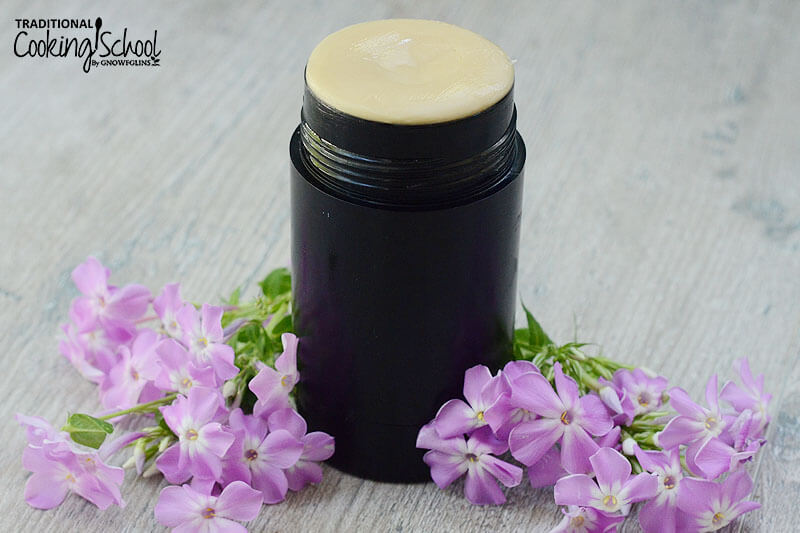
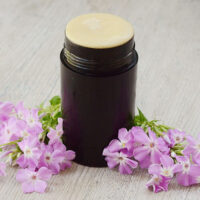
Wardee's Natural Homemade Deodorant
With Bentonite clay for sensitive skin, this homemade deodorant fights body odor, absorbs excess moisture & soothes irritation naturally! Makes about 3 tubes of deodorant (depending on tube size).
Ingredients
- 1-1/3 cups coconut oil
- 1-1/2 tablespoons beeswax pastilles increase during summer or in hot climates
- 1/4 cup baking soda
- 3/4 cup arrowroot powder
- 2 tablespoons Bentonite clay
- 25 drops tea tree essential oil optional
- 5 drops lemongrass essential oil optional
Instructions
-
Melt coconut oil and beeswax together over low heat until just barely melted.
-
Remove from heat.
-
Add remaining ingredients except essential oils.
-
Let cool, stirring every 5 minutes or so, until it hardens to a pudding consistency.
-
Put in the fridge to speed this up, checking and stirring frequently.
-
Add essential oils and mix well. Spoon into empty deodorant containers.
-
Let harden overnight in a cool location. You can speed this up by putting in the fridge to harden.
Recipe Notes
Don’t have an empty deodorant container? Use a pint or half pint jar. Use about 1/8 teaspoon for each arm.
Or, use muffin tins to create a “cake” of deodorant. Keep wrapped in tissue paper when not in use. Rub the cake under arms to apply.
The texture is quite hard after sitting in a cool location, and quite "soupy" during the middle of a warm day. To keep it the right consistency, I recommend storing it in a cool location and/or doubling the amount of beeswax.
Have you ever experimented with coconut oil deodorant recipes? What were your results? Which essential oils do you like to add to your favorite homemade deodorant recipe?
This post was originally published and written by Andrea Sabean on 8/27/13. It was updated and republished on 9/21/20.
...without giving up the foods you love or spending all day in the kitchen!

2 free books:
Eat God's Way
Ditch the Standard American Diet, get healthier & happier, and save money on groceries...
We only recommend products and services we wholeheartedly endorse. This post may contain special links through which we earn a small commission if you make a purchase (though your price is the same).


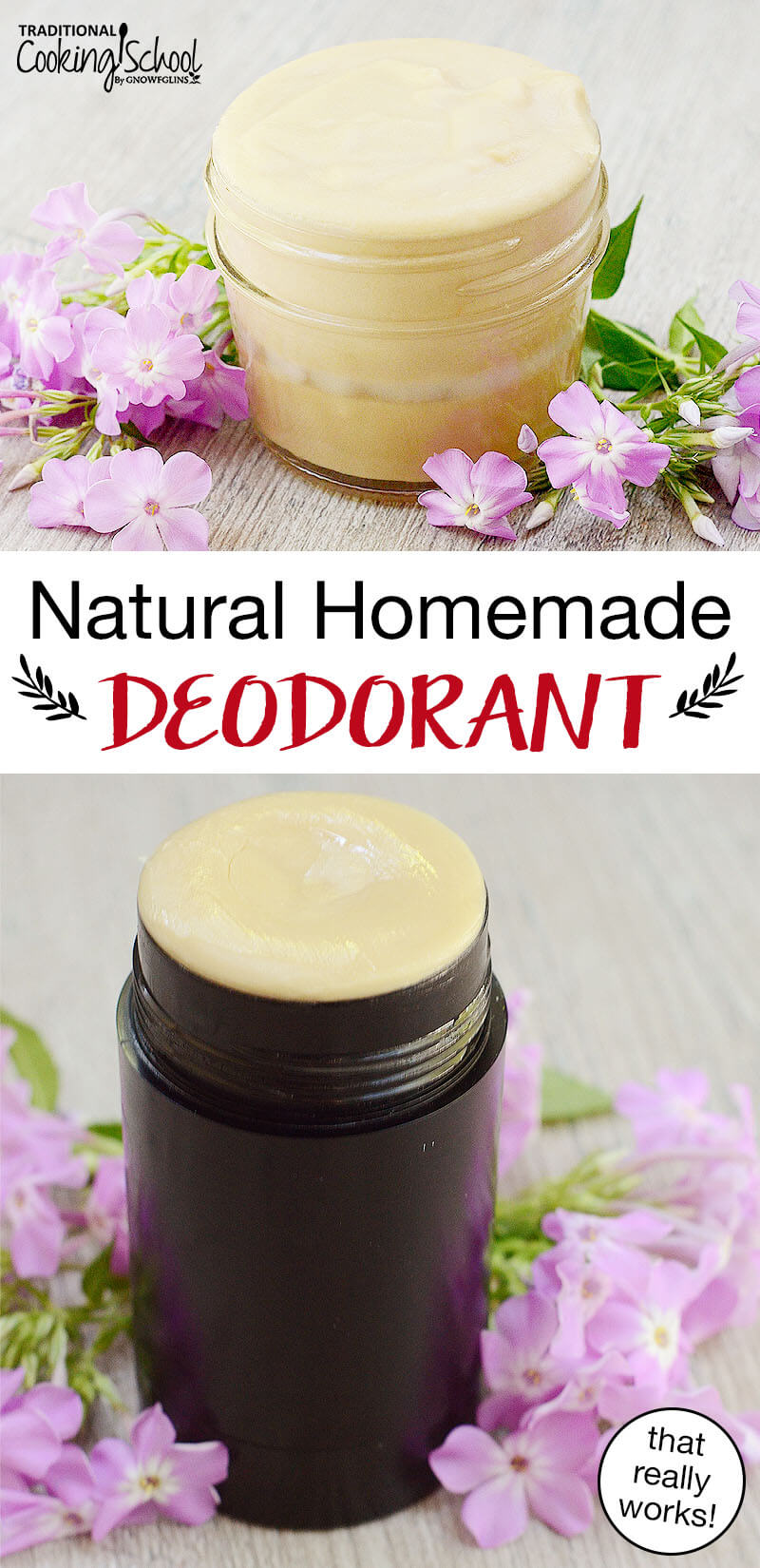
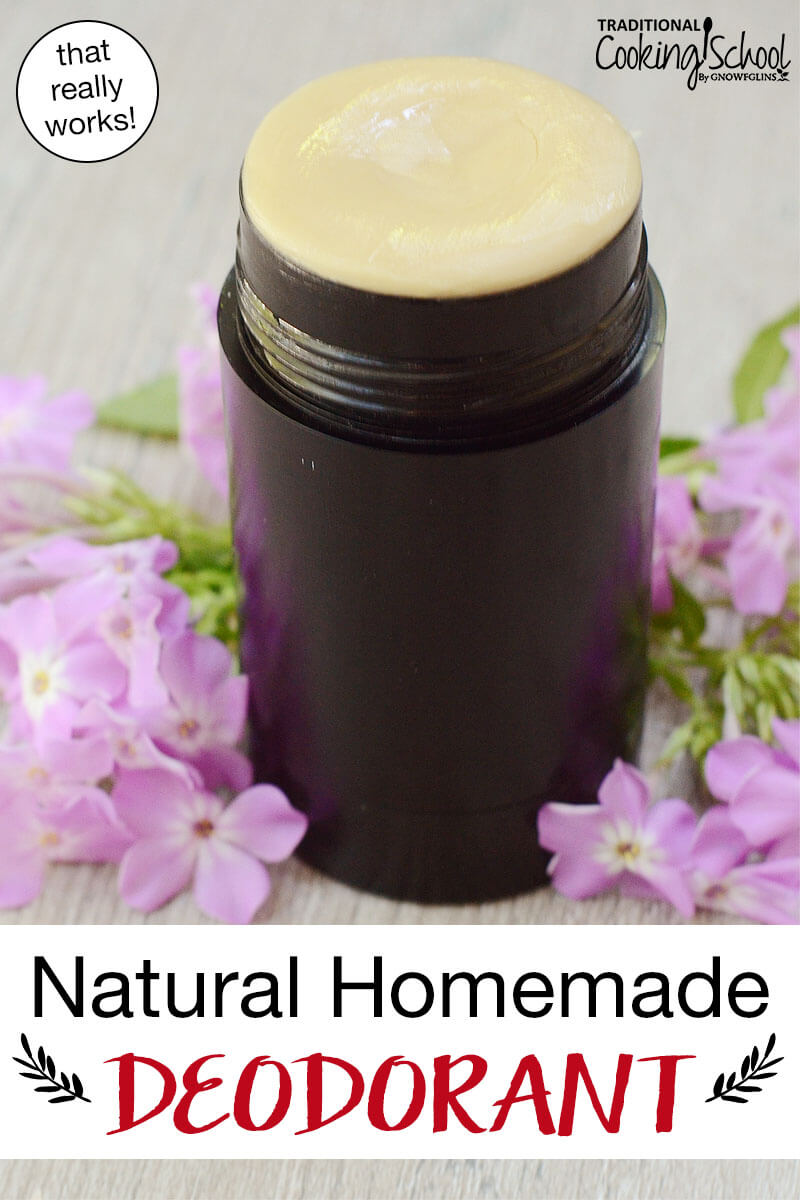
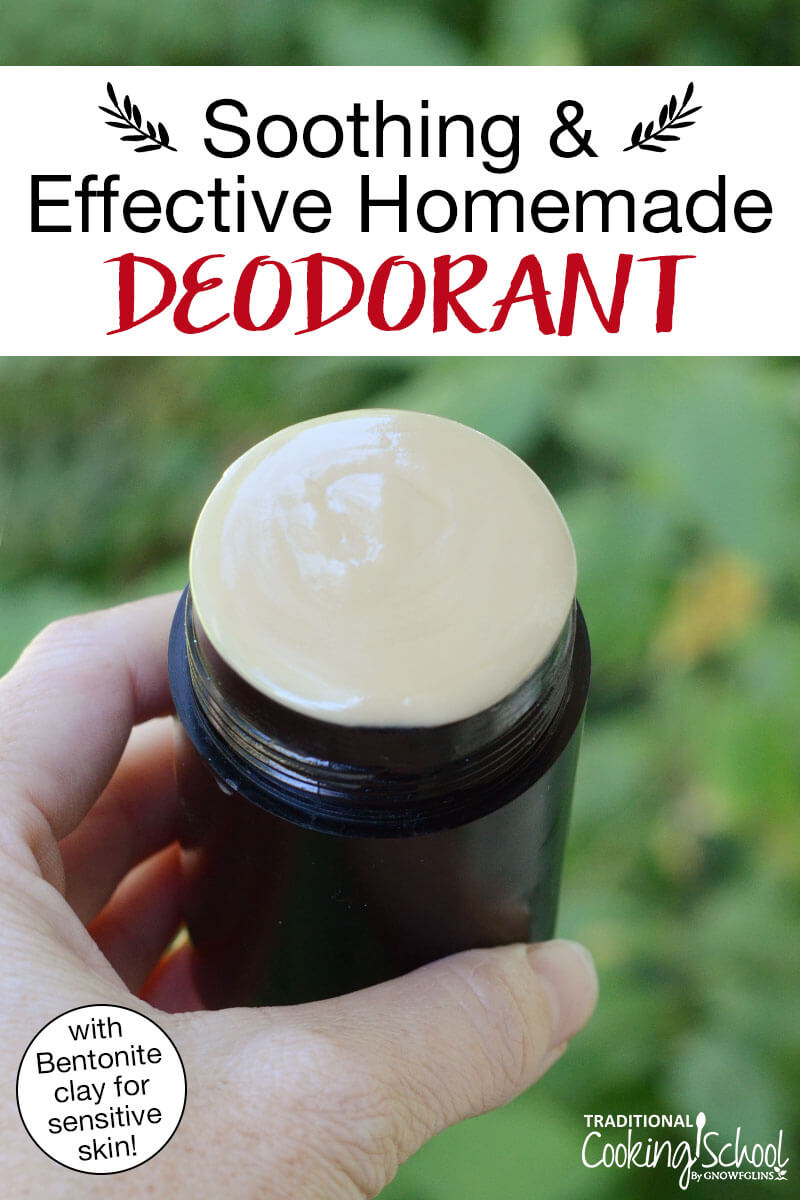
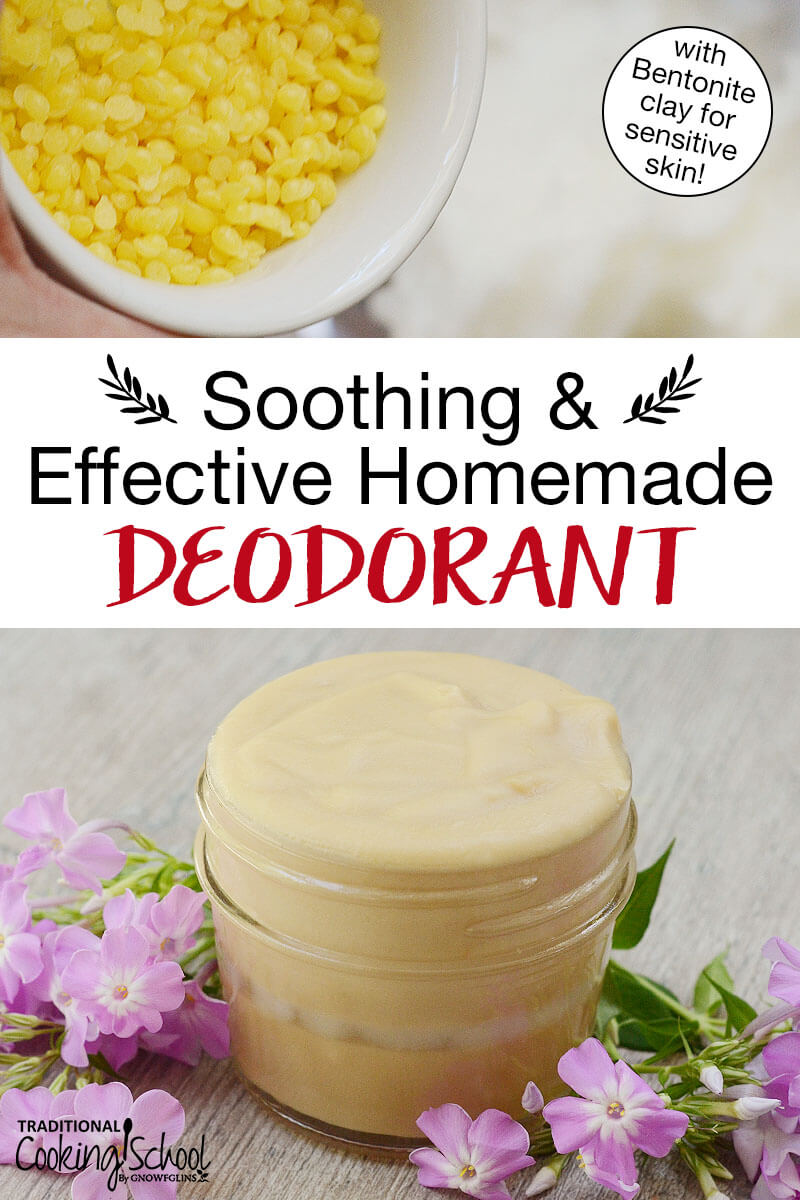
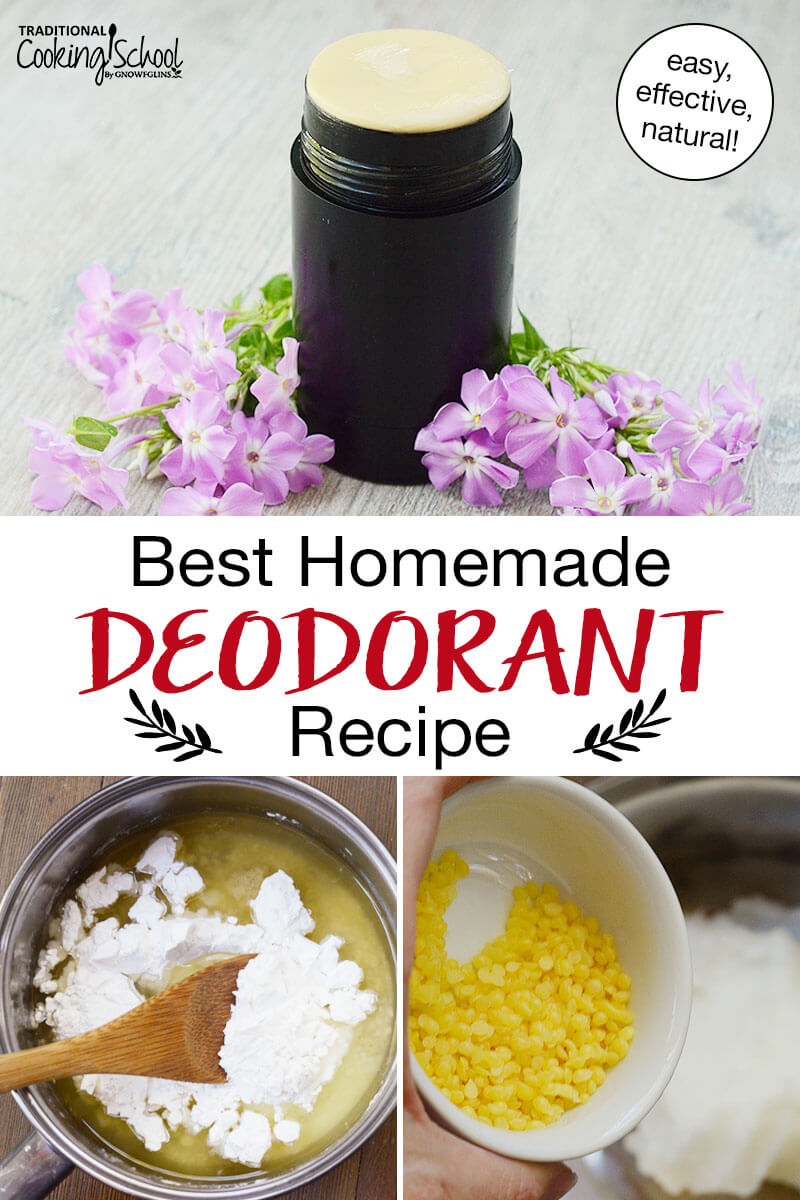
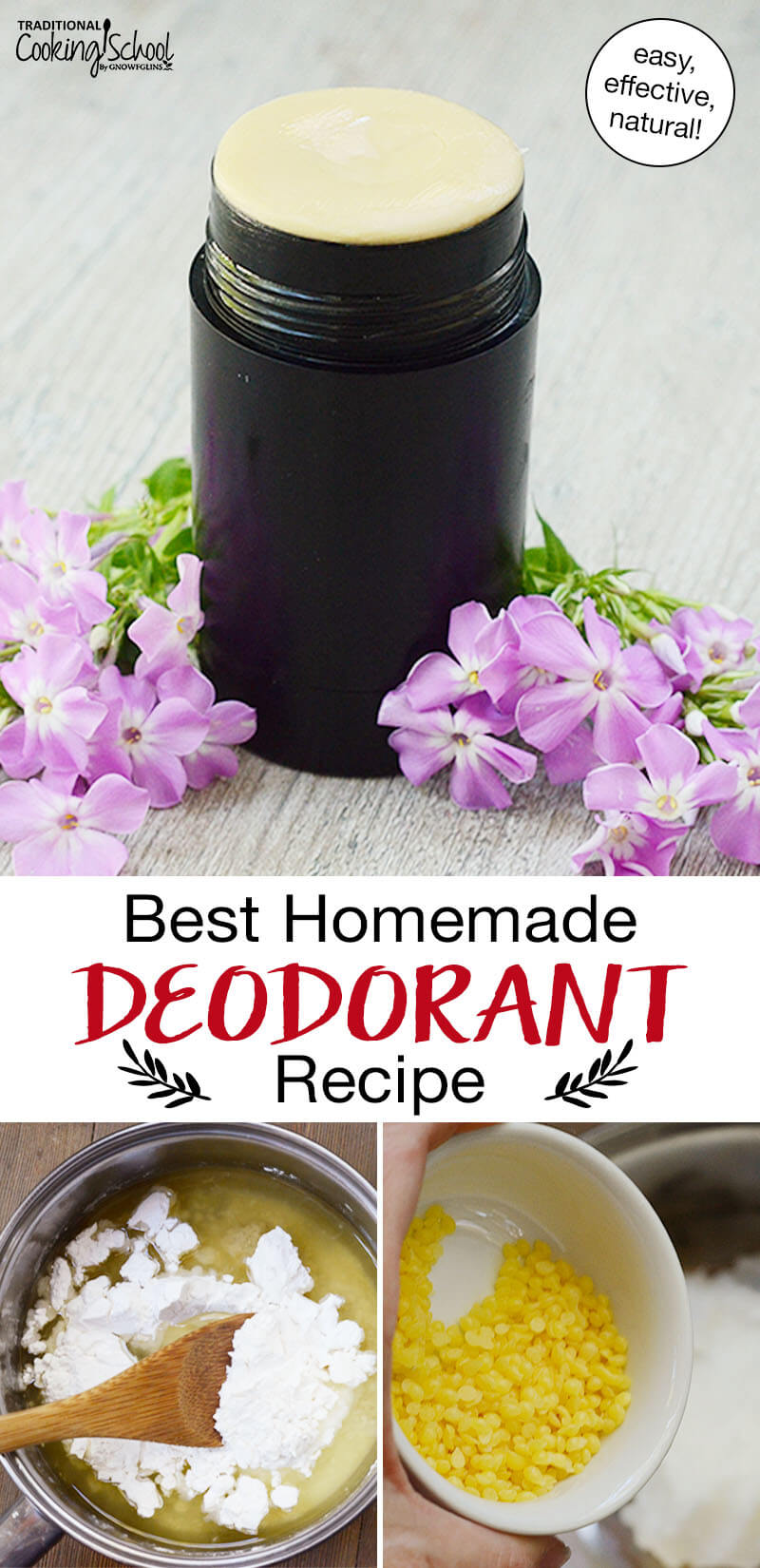
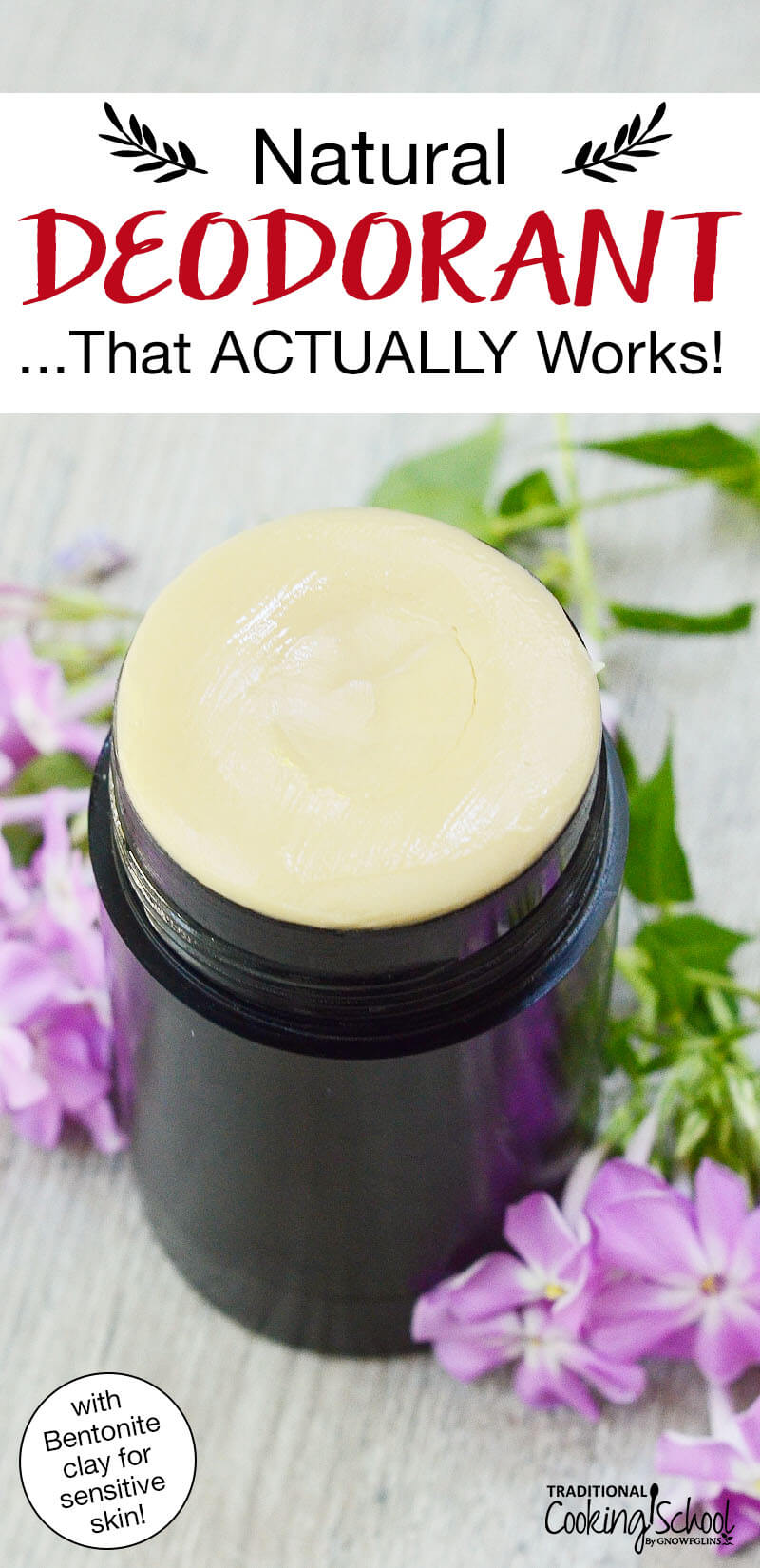
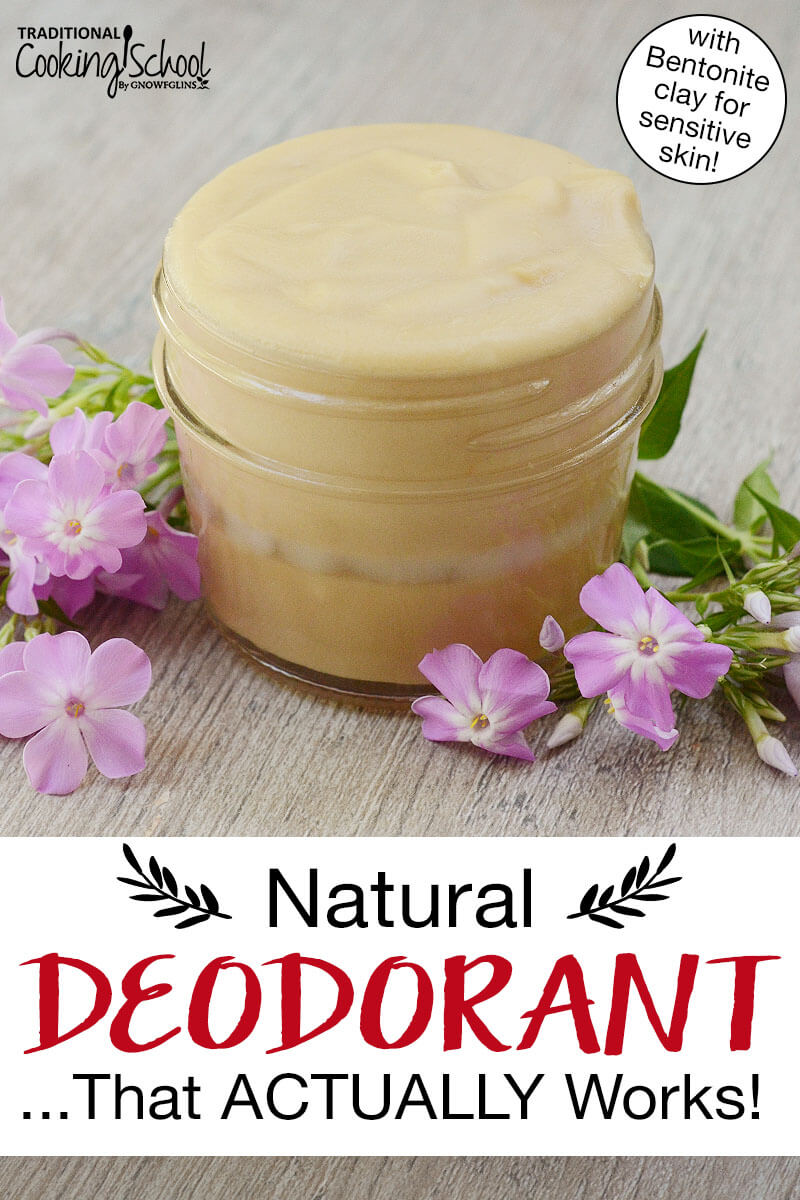
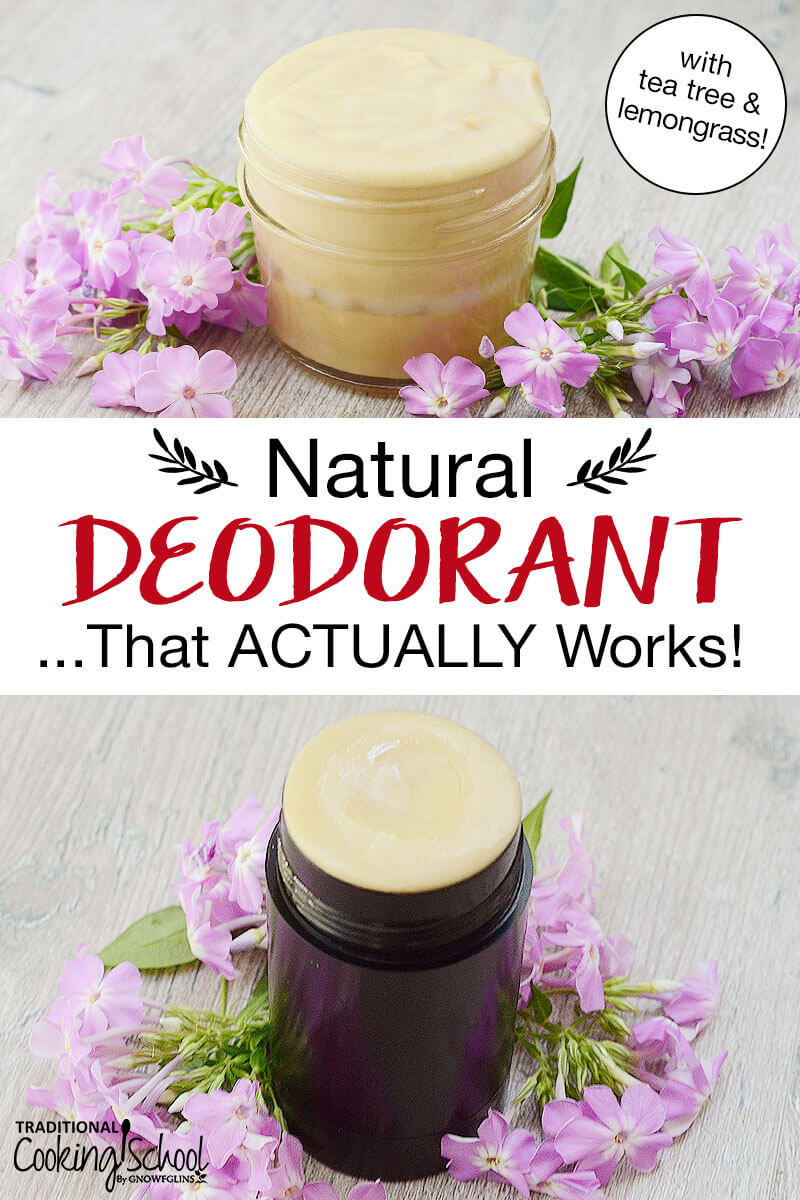
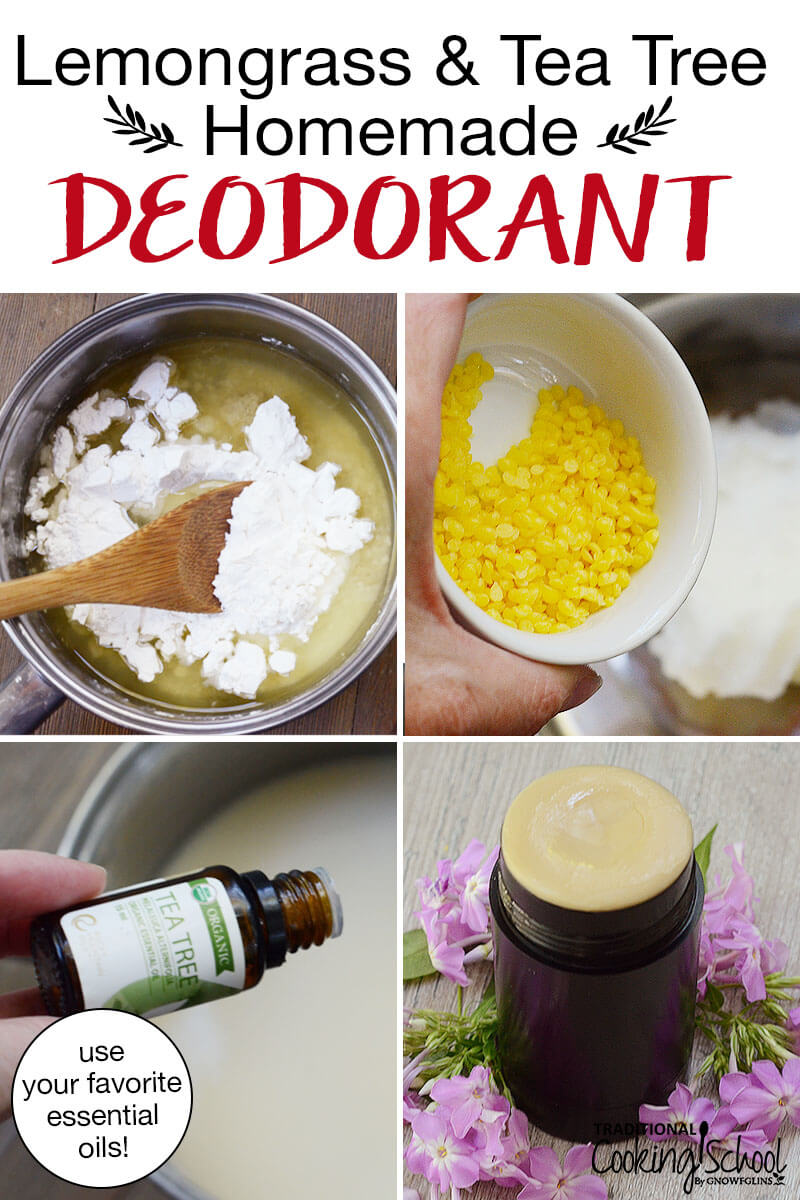
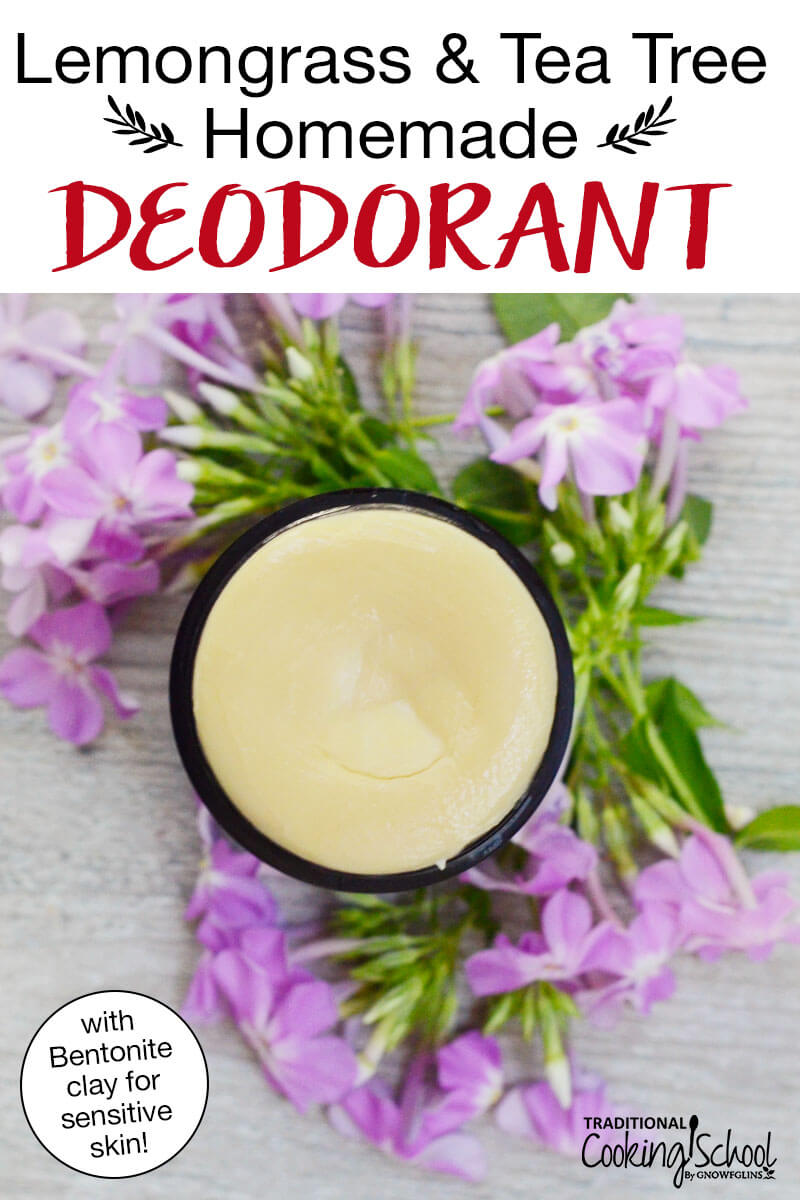
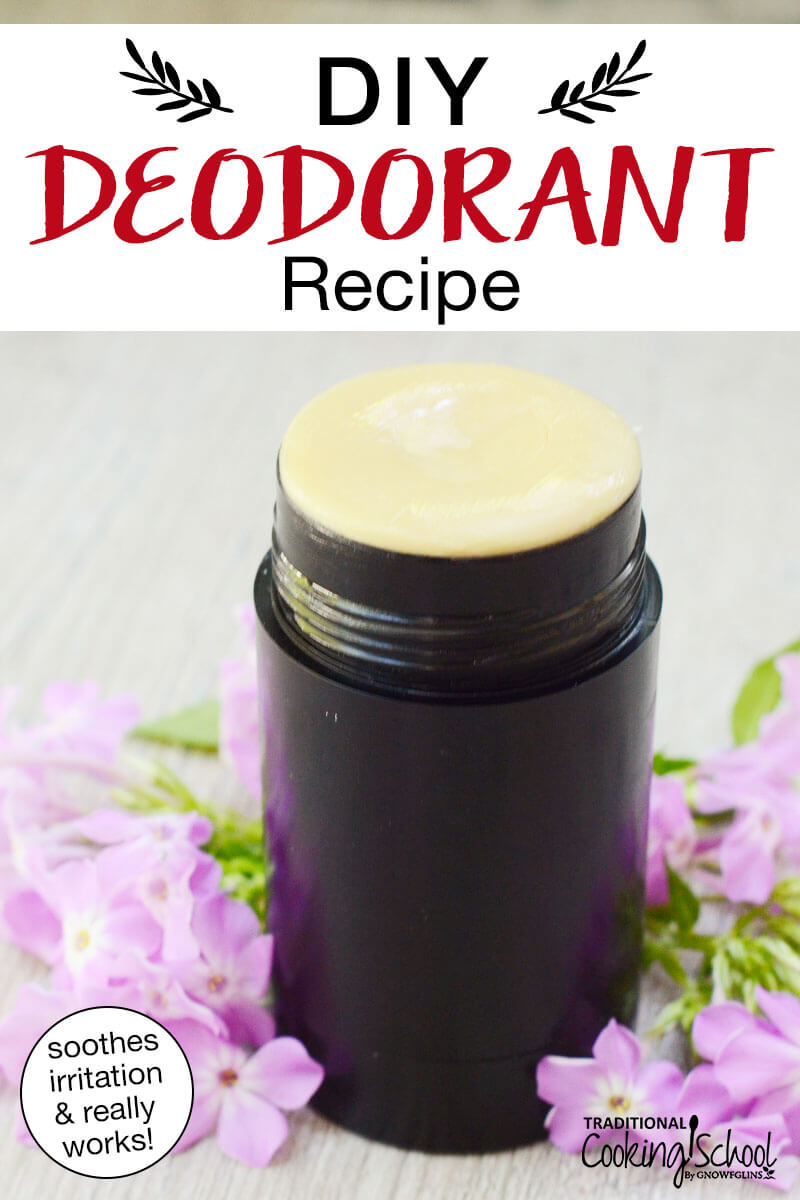
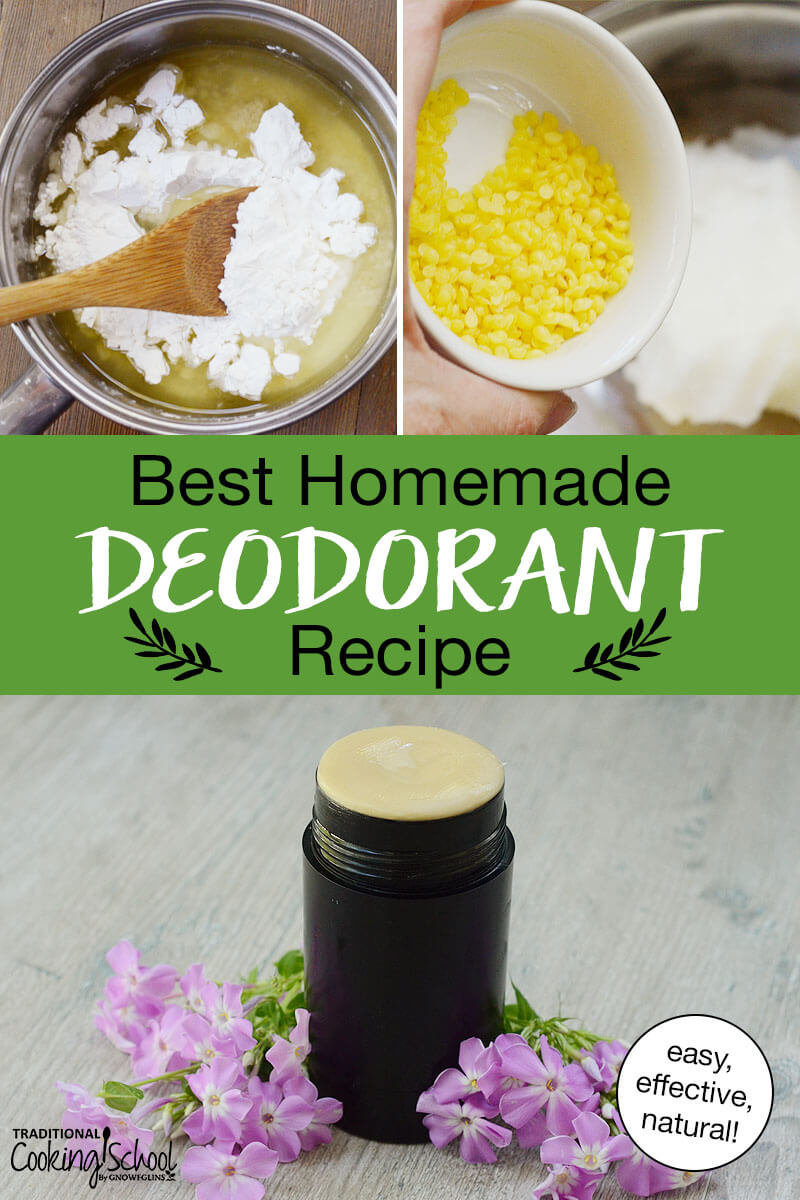
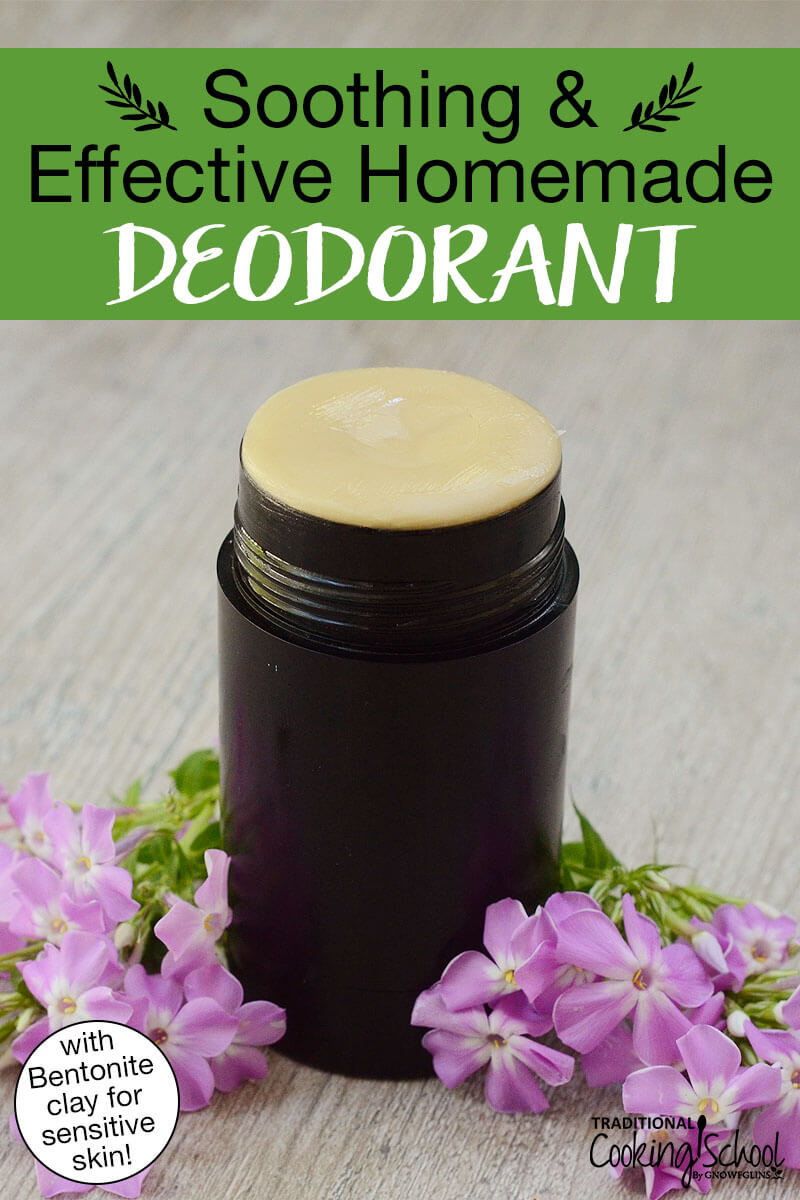
Have read many places recently that having fingers come into direct contact with
Skincare products should definitely be avoided at all costs. Bacteria & a host of other
Contaminants can be readily transferred, in this case to an open jar, & the integrity of the product begins to break down when constantly in touch with fingers. I am looking for a deodrant formula that could be added to a roller, pump, or non-aerosol spray bottle.
Thank you!
Marilyn
Marilyn, I would say that most of us apply deodorant right after bathing. I think it would be safe to assume that applying deodorant with clean fingers would eliminate any risk of contaminating the jar with bacteria. Additionally, coconut oil and tea tree oil (which are used in all 3 recipes) are anti-bacterial in nature anyway–thus the reason why they are perfect for deodorant, where underarm bacteria causes body odor. If you are really wanting something that never touches your fingers, you could use Wardee’s recipe, which says it can be added to an empty deodorant tube.
Maybe use a small spoon to take out only what you need?
Yes, I agree with LIndsey that you could use any of them in an empty deodorant tube if you’re concerned about touching the bottle. However, they all do get kind of “soupy” at room temperature in the summer. I may store in the fridge to be safe if you do try an empty container. Also, I wouldn’t travel with them in a deodorant container unless you bag it or put in it something else to prevent a leaky mess 🙂
You could use a spoon or q-tip or even a cotton ball for application as well. 🙂
This was such a great overview! Thank you 🙂 I have been making my own for over a year, and finally found a version that works well for my husband and I. If he’s happy, it works for me 🙂 I started with Lindsay’s recipe I think, but use twice as much arrowroot as baking soda to make it less irritating, and I add coconut oil only until I get the texture I want, which isn’t much in the summer (ours was still a paste in the summer. I’m sure I’ll use more in the winter). I do add some tea tree and sometimes some other oils as well. This inspires me to add a little Bentonite clay since I have some (for toothpaste!) and I had been wondering about the staining.
Oh, and I make a tiny batch at a time in a baby food jar and then I don’t worry about putting our fingers in it. You could also make a big batch but use it from only a small jar at a time. I did notice when I used a big jar of virgin coconut oil for moisturizer and would scoop it out with my hands, that it would smell funny or get a little gross after awhile, even with its natural antibacterial properties. My guess is that the problem is more water droplets getting in than my hands touching it though. Hopefully a small jar will solve that problem for me!
Thank you again!
Thanks for your good tips! I was wondering how to decrease the baking soda, since it does irritate. I keep my deodorant in a small jar and it never has lost its consistency (Unless it’s warm) and has not smelled. I found I can’t use lemongrass oil because it makes me stink! Try different oils and see what works best for you; i’ve not used teatree because I don’t always like its smell either.
yes, I do something very similar, 1 part baking soda, 2 parts cornflour, mixed with enough coconut oil to make a runny paste. I whip it hard till it feels soft and smooth. I put it in small containers and have 1 each per person. By only making enough for a week or two, there is less chance of contamination. It really works well, even in our subtropics. It also works for foot odor, tinea cleared up completely.
Adding a small amount of beeswax takes this to an ideal consistency to pour into a deodorant tube (Can get empty ones on amazon if you don’t have some of your own lying around) – when the liquid cools it’s perfect! That’s how I’ve been using mine and they don’t melt in hot weather or travel.
Use a pint size caning jar and a pump from Walmart for 99 cents. Drill hole in top use a little glue gun and glue the pump to the top pour mixture in jar. Pump onto fingertips and there you go. You may have to cut the stem of the pump to fit the jar.
I’m with you there. Here’s a spray recipe from One Good Thing by Jillee,
1/2 c. witch hazel
1/4 c. aloe gel
1/4 tsp baking soda
10 drops EO (optional)
If you want a solid one you can pour into a deodorant stick dispenser Jillee’s goes
1/2 c. VCO
1.5 Tbsp pure beeswax
1/2 c. baking soda
10 drops EO
Melt and pour into stick dispenser.
Baking soda can be harsh on your arm pits, you may want to experiment with a reduced amount. It’s the virgin coconut oil that is the deodorant. Good luck with them.
What does the EO stand for?
Essential Oil, sorry.
DIY Super Strength Deodorant Spray: 1 fl. oz. witch hazel, 1/2 fl.oz. flower water hydrosol, 1/2 fl. oz. colloidal silver, 20 drops essential oils, 10 drops grapefruit seed extract. Add all ing. to a 2 oz. mister bottle. Shake well.
I used lemongrass e.o. because it is for excessive sweating, also petigrain is too. I like the deodorant just fine. I happened to have some rose water hydrosol made by a friend, luckily.
I place my homemade deodorant into these deodorant containers that I get for about $1.50 each, and reuse them. http://tinyurl.com/pwjs8sm
Isn’t there bacteria growing in our underarms too? Using a deodorant tube would also result in the container coming in contact with bacteria. For that matter, the same is true of commercial deodorants. These recipes contain antibacterial oils, that’ skincancer the point of deodorant. A little contact with your fingers will be fine.
Oh this was fun reading!!! So informative and thanks for doing all the “leg work” for us! Look forward to more of your experiments! Thanks Jenny!
So glad you enjoyed it, Karen!! 🙂
Thank you for this! Very informative and will help save us all time and money. Love your blog 🙂
Thanks, Mandi! 🙂 After all this fun, I will never go back to commercial deodorant again 🙂
I’ve been using Passionate Homemaking’s recipe for a few years now. I’ve always added tea tree oil (or lavender or peppermint). Three seasons of the year, this works great for me; but during hot West Texas summers, it often takes 2 (or 3) applications a day to be effective for me. I sweat a lot too when I’m hot. I have everything in my pantry to make Wardee’s recipe, and as luck would have it, making deodorant was on my to-do list today anyway! Thanks for this great comparison!
Thanks so much, Lindsey! 🙂 I had started out using Passionate Homemaking’s too..and hers is really handy just because it is so simple. However, it hasn’t worked for us in the summertime..I’m going to keep it in my “file”..maybe just for winter when I’m in a hurry. 🙂
Thanks for sharing! Do you know if the deodorant leaves stains in the arm pits at all? #oils4everyone
Michelle, see my stain test above 🙂 I have heard of two people that said the recipe containing clay left some staining..but in both cases a lot of deodorant was applied. I’d recommend a smaller amount and rubbing it in really good if you find that happens.
I have been using Passionate Homemaking’s deodorant for a couple years now. My husband and I only need one application to make it through the day. I add tea tree oil and lavender to it and usually have to add extra arrowroot and baking soda to get the right texture. Mine does not lump or need stirring ever. I just use the back of a spoon to mix the ingredients together. I store it in an old powder jar and an old hair wax container. This summer it was particularly hot and I was sweating in other areas. Applied this each morning and not a smell all day. Thanks for this review; I may try the others, but I may not since this one works so well for us! 🙂
So glad that Passionate Homemaking’s is working for you 🙂 I like the idea of adding lavender, I almost added some this batch but decided not to since I wanted my husband to try it and I didn’t think he’d go for it. Maybe I’ll separate some just for me and add some. 🙂
I have been using Wardee’s recipe for a while. While I like it, my husband has had terrible problems with staining. I did notice how he rubs it on for a LONG time and I told him he didn’t need to use so much. I am wondering if maybe the stains have to do with the beeswax which has a higher melting point and doesn’t seem to respond to soap the way that oils do.
He just has several shirts that I have not been able to get the stains out of – I even tried the steam setting on my washer which did lessen them but it is still pretty obvious.
Has anyone else had this problem?
C, I’m so sorry you’ve had problems with staining! I didn’t think about it being the beeswax but that makes sense. I wonder if the amount he’s using, the amount of beeswax or clay, or the color or material of his shirts is what makes the difference..good luck!
I just clicked the link on Wardee’s deodorant post to check the comments and someone did say they had residue left after using it, but that it was probably due to not rubbing it in well or using too much. I’d try that first and see if it takes care of the problem. 🙂 https://traditionalcookingschool.com/2013/07/11/wardees-natural-homemade-deodorant/
My husband uses ALOT of my homemade deodorant, too and has bad staining on most of his shirts. He thinks if the shirt doesn’t smell or has dirt on it, it’s ok to hang it back up in the closet. I’m thinking that the excess deo on the shirt and sitting in the closet is causing the staining. But can’t convince him of that!
We use the wellness mama recipe and my boyfriend has TERRIBLE problems with staining. It is mostly on dark clothing and shirts that are all cotton (really, why couldn’t it have taken out his poly-blends?!). He applies it lightly and waits several minutes for it to “set” before putting his shirt on. I have treated the armpits of his shirts with scalding water and two different natural stain removers to no avail. We used Schmidt’s for a while and I loved it, but he got no stains and an allergic reaction, so homemade wins. I found this article in a Google search hoping to find how to get rid of stains. If anyone has similar problems and has found a trick, please let me know!
Tammy, I have been using this solution for perspiration stains on clothes: 1 part hydrogen peroxide, 1 part washing soda(NOT baking soda), 2 parts water(I use distilled water) NOTE: I only make what I will use, and dispose of anything left over. For example 2 tsp. hydrogen peroxide, 2 tsp. washing soda, 4 tsp. distilled water. Mix together in a small container, then pour onto stain and rub in. Let it set for a bit, then wash as usual. It has worked wonders for me, I hope that it does as well for you!
I have used a slightly different recipe that did not have clay, but has beeswax to keep the consistency from becoming soupy. I like it, but the beeswax DOES stain my clothes. I have 2 shirts where I even tried to iron the bees wax out, but it isn’t moving. It is a yellow waxy stain that does not move when washed. I made such a large batch of deodorant too. So next time I would use less or no beeswax and deal with the soupy consistency. The consistency is not what makes it work. Thank you for this review. I might experiment now and add Shea butter and clay to my recipe.
I have tried so many different types I have ended up using just a salt stick. I’m game in trying out these recipes and see how it goes. My last homemade batch ended up burning my underarms to the point of peeling. I’m not sure what it was. I used arrowroot, baking soda and clay. Hate to make another batch and get burned again!
I haven’t had a problem with it, but I know some people are sensitive to the baking soda. Maybe try leaving that out next time and add a little more arrowroot till you get the texture you want.
I agree, that it probably will take some experimenting. Let us know how it goes!! 🙂
I have to be careful when making homemade deodorant because I get burned from the baking soda. See if you can find a recipe without soda, that may be the issue.
I love making my own deodorant and the once a day application is great! But I too get “fire pits” from too much baking soda. I’ve tried using clay and less soda. I’ve tried Jillie’s recipes to no avail. One good thing about it, once your pits peel, they are REALLY smooth. My next attempt will have crushed acidophilus tablets. Maybe that will work, not giving up!!!
Thanks for these recipes and thanks to all who commented. I have some of the ingredients (coconut oil and tea tree and lavender). My cocomut oil smells kind of coconutty- has anyone had a problem with a coconut smell? This is the one that comes from Costco…
Personally, I like the coconut smell, but if it bothers you, you could add more of your favorite smelling essential oil to “mask it” so it is more enjoyable to you 🙂
I use a recipe with clay, probiotics and arrowroot in it…and Shea butter! I would be happy to locate it if you would like! When I need extra oomph from it, I dust on baking soda…but generally speaking the baking soda makes me break out so i don’t add it in.
I would love to see it if you can find it, Marisa! 😉 Thank you!
I think that sounds like the one I made. I like it a lot. If you can’t find the recipe for it, then I can post it. I used a Young Living Oola Balance for the e.o. I just love the smell of it. I think I need balance, anyway! lol.
I use Passionate Homemaking’s recipe except I double the arrowroot/cornstarch and I added some vanilla in addition to the tea tree oil. I only need one application per day. I even tried skipping a day to see how long it worked and at the end of the second day, I still had no bad smell. I absolutely love this recipe. I found the best way to store/apply it is to use the baby bottles with the drop in liners, the nipples removed, but the ring on. This contains the coconut oil on warmer summer days (my re-used deodorant container leaked) and it makes application very easy.
So glad you found something that works so well for you! 😉 What a creative storage idea! I think I have some drop in liners, will have to give that a shot!
I have made and used the Passionate Homemaking version and it worked very well, EXCEPT, my underarms soon broke out horribly in a red, bumpy rash. Would it be the baking soda causing that? Also, I used cornstarch since I didn’t have any arrowroot on hand.
Hi Sharon, I would definitely guess that it is the baking soda. Many people are sensitive to it Sorry to hear that you broke out. I think you might have better luck with one of the other recipes…maybe try Wardee’s, she had some family members that had trouble with baking soda as well and hers was ok for them. 🙂
Thank you Jenny, I’ll try Wardee’s recipe! 🙂
Hi,
I just made Wellness Mama recipe for deodorant. Great stuff. I just need it once a day.
But I used a little more coconut oil and a little less baking soda and shea butter and I added some essential oils aswell. Also,…. I added some drops of lemon juice.
4 teapoons coconut oil
1,5 teaspoons baking soda
1,5 teaspoons shea butter
1 teaspoons arrowroot powder
A few drops (3 max.) of lemon juice, tea tree oil and vitamin E oil.
Works like a charm for me. Great website by the way. I like what you guys are doing with this community.
Bye! Marilyn G
Thanks for sharing what you’re doing!! 🙂 Sounds very similar to the recipes above! 🙂
I use recipes #1 and #2 and after a few months of using my arm pits looked and felt very painful. itchy and peely and leathery. After much research it’s definitely the Ph in baking soda. It is very very harsh on our skin-it has a ph of 8.3 something and most skin care products recommend a ph of anywhere from 4-5.5. I plan on making new batches and using ONE TEASPOON of baking soda bc 1/4 cup is way way too much. Even one tablespoon was too harsh for me. It’s strange bc I dont typically have sensitive skin. I can leave my make up on overnight and I’m still blemish free…just blessed that way, but throw off the Ph and yikes!!! anyway, I recommend starting with a low amount of baking soda and work up to more if you’re not finding the results you want because healing that sensitive area after the damage is a long process.
Great advice, Brittany 🙂
Natural deodorants are a safe, effective option. Lavilin is considered to be one of the best brands in the market and I highly recommend trying it out for all those who are considering making the switch. http://www.lavilin.com
thanks, Lily 🙂
Hi Jenny,
Thanks for sharing! I dont have Redmond clay. What is readily available is something called Multani Mitti, a bentonite clay from a local Indian store. This clay is used for face masks, Do you think that it might work instead? I would love your thoughts on this!
Fatima
I think it would probably work just fine. 🙂 The main concern with bentonite vs. nonbentonite clays has to do with consuming them. Since your bentonite clay is used in face masks and is probably healthy for your skin, I would guess it would have the same benefits in a deodorant. 🙂
Refined or unrefined coconut oil?
Two options at the supermarket.
Not sure what to get.
Can you get Shae Butter at supermarkets?
I don’t know.
We use unrefined coconut oil. I have seen shae butter in natural food sections but outrageously expensive. I order mine from http://thesoapdish.com (if you order, let them know Wardee sent you!).
Sorry for the delay on my response for this, I must have missed the email here. Yes, I agree with Wardee on both accounts..unrefined coconut oil is the way to go and I’d source the shea butter elsewhere, and check out Wardee’s link. Mine came from a source that was local in South Carolina where I was visiting and they don’t ship it.
Can you please tell me where in SC you got your Shea Butter? Thank you!
I have made deodorant with baking soda, arrowroot, coconut oil, & lavender and eucalyptus EO’s, but I wanted it to be a little smoother and stay a little more solid in the summer, as I live in the Phoenix area of AZ. I recently purchased some shea butter and I was so excited to find the second recipe. I was very easy to make and smelled great with the extra scent of the shea butter. After several uses, my right arm seems to get more exercise, and so, well, it didn’t seem to be working so well on that side. So I decided to modify the recipe. I just reheated the glass container in a warm bath. I had my EO’s there again just in case they were heated out. I added more 1 T more of coconut oil and 1 1/2 T more of baking soda, and the EO’s were just as fragrant as before. I am using it for the first time now. So hopefully that works. If it doesn’t work, I guess I’ll add a little bit more EO’s and if still no, I might have to scratch the shea butter. I hope not, I’ll keep my fingers crossed! Suggestions/ experience welcome! 🙂 Thanks for listening.
The extra baking soda should do the trick as long as you don’t find the higher concentration irritating. Let us know how it goes!! I agree the shea butter is lovely, I don’t blame you for not wanting to give it up 🙂
It worked! When I first put it on it feelsa Lil more rough but then it’s fine and best part is that it works fabulously . Thank you!
Shara, that is wonderful to hear! Thanks for coming back to share! I agree, the texture is a little bit more rough than commercial types. I think I might try it with a blender for just a few seconds next time and see if that smooths it out. It’ll be quite a while, though, I’m not even through the first jar of these yet! 🙂
Will try it out!
I’m a Lavilin customer. It’s great!
I buy it on their website (www.lavilin.com). Love it!
Thanks, Kirsten!
For awhile I was just using straight coconut oil because baking soda was irritating my skin. Seemed to work okay most days, and I would sometimes hang my worn shirts back up if they looked and smelled clean. A couple weeks later when I would go to wear the same shirts, the underarms smelled so badly I’d have to throw them right in the dirty clothes. It seems that an offensive, rancid odor would develop over time on my shirts. Now I’m back to using store-bought natural deodorant (not very effective), and laundering all shirts after one wear. Anyone else ever notice this problem with coconut oil?
I don’t have any experience with this. I am guessing the coconut oil went bad over time and the exposure to the air?
I had this problem with commercial deodorants until I switched to natural. It’s your sweat stuck in the fibers, and my guess is that the oil, which doesn’t release so easily in the wash, is also holding the bacteria from your sweat. I mixed up a baking soda and water concoction that I pour into a spray bottle. I keep it next to my hamper and soak the arm pits of my clothes just before tossing them in. Before this will be enough, you should give your offensive clothes a good scrubbing with a Dawn/hydrogen peroxide/baking soda treatment and old toothbrush.
I use a mix of coconut oil, shea butter, and diatomaceous earth. I find baking soda irritating and have heard that it provides a more inviting environment for candida growth. The DE is also an odor absorber. I add a little lavender oil for fragrance, and I am very happy with the results even on warm days. I been using this for months without finding any clothing stains.
That’s terrific, Elizabeth and sounds like a lovely recipe! 🙂
Elizabeth, could you give us the recipe?
I have experimented a lot with natural deodorant recipes and have used similar recipes to all three of these. I like the one with the shea butter best. When I used a recipe with bentonite clay in it, my armpits had a mild wet dog smell. I definitely didn’t need an additional odor in my armpits!! Maybe it was the brand of clay I used. I like to combine citrus, lavender, and tea tree oils in my deodorants, but if you really want to cover odors, I would suggest a musky oil like sandalwood, frankincense or patchouli.
Thanks for the tips, Sybil!! What type of clay did you use? I used Redmond Clay in mine and didn’t notice any smell. I like the combination oils you use – that sounds wonderful and will have to give it a try!
On the Wardees recipe, is it required to use those two essential oils or are they mainly for scent and can be swapped with any other essential oils?
You can feel free to swap, they are for scent. 🙂 However, Tea Tree oil does have a lot of healing properties and I’ve noticed much less irritation from shaving since including it in my deodorant, so that one you may not want to give up entirely. 🙂
Interesting! I am going to try the 3rd recipe with the clay. I have white cosmetic clay on hand and will try that.
Great, let us know how it goes!
I have made natural deoderant with coconut oil, baking soda and arrowroot and it works however when I put the mixture into rollon deoderant bottles and the weather is cold it goes hard and doesnt roll on. Putting under hot water is a pain. Anyone got any ideas
I used Redmon’s Bentonite Clay, baking soda, and virgin organic coconut oil. It lasts sometimes 2 days! My very hard working days it sometimes falls a bit short but I love it.
Thank you for testing these for us! Very helpful post! Just a note – the clay can contain trace amounts of lead (according to Iherb.com that sells Earthpaste toothpaste containing this ingredient). So children and pregnant women should avoid using it (they say). Might be different with stuff you don’t put in your mouth though.. but just wanted to say. (But it doesn’t stop me from using the toothpaste…) 🙂
http://www.iherb.com/Redmond-Trading-Company-Earthpaste-Amazingly-Natural-Toothpaste-Peppermint-4-oz-113-g/45320#p=1&oos=1&disc=0&lc=en-US&w=clay%20toothpaste&rc=5&sr=null&ic=1?at=0/bix900
Baking Soda really irritates my skin; can arrowroot be the main ingredient instead of using both?
Thank you so much for this article review. I’m very active and sweat when I exercise. I’ve been trying to buy over the counter deodorant that doesn’t contain aluminum but they don’t work and have now been searching for homemade recipes. Seeing this post review has really helped me make a decision on which one I’d like to try to make.. thanks again..
Olla,
I’d been using the crystal stick for a while now but it wasn’t performing up to standard. I was quite excited to find homemade recipes for deodorants as I’ve been maintaining a healthier well being and lifestyle for a few years now. I made the wellness mama deo and it’s worked very well no smells at all. I didn’t have arrowroot so I used more baking soda and I had to put it in the fridge as it was attacked by ants when I left it out. Not up to a week after I started using it I had to shave my armpits and noticed that my skin had completely dried up and was tough like wrinkled old skin. I have stopped using it and I’m wondering was the baking soda too much? By the way I live in Lagos, Nigeria.
I’m having trouble, specifically my arm pits get burns after using this deodarant and they itch and itch. I made the third one and I REALLY want to use it. HELP!!
Stop using the baking soda!!! After the rash every person in my family got from the baking soda….too alkaline….I could never recommend it in a deodorant. It’s not just an inherited sensitivity either because it happened to me and my husband. Even if the recipe already calls for arrowroot powder, I also replace the soda with more arrowroot….same amt as listed for soda. Very simple recipe, too. One half cup coconut oil and 1 & 1/2 tables. bees wax pellets melted. Stir in one cup arrowroot powder. Pour into deodorant sticks or a jar. If too stiff, try a tiny bit less beeswax. I little bit, more or less, makes a big difference. Don’t store where warm.
I also don’t put essential oils in it. I like the natural scent of the coconut oil. I put lime in it one time an it smelled just like Bath and Body Works…..but the lime was too harsh on our skin too.
In the last recipe could i use potato starch instead of arrow root or corn starch?
I’ve been using Wellness Mama’s recipe for 4 weeks now without the arrowroot powder, and I only need one application every 24-36 hours, depending on how often I shower. I can even make it through Zumba class in the evening after a morning application. I am a sweater, but at least I don’t stink! No staining yet but I have to be careful with dark clothes.
I made wellness mamas recipe, but I dont think it works! Ive wore it twice, and I stink within 2-4 hours, even when I dont sweat! Did I possibly mess up the recipe? What can I do to make my current batch stronger? Idw throw it out!! Also, my shea butter did not give it the same color as described above.. my deodorant is white! I did add the shea from the NOW brand. Please provide some suggestions so I dont waste the batch of wellness mamas deodorant that I had doubled.. lol!
You all should try a few drops of lemon juice rubbed under the armpit after shower. I was amazed by how well it works. May be too acidic if your skin is very sensitive but it hasn’t bothered me. I have used natural deodorants and none have worked well for me, the lemon juice works.
I have been making and using the Passionate Homemakers deodorant for a long while now, I use equal amounts of coconut oil, arrowroot and baking soda, i only need one application, when getting out of the shower every morning, I can exercise on hot days and it works a treat, best thing ever. It will stain your bras, shirt underarms etc, but you just need to make up a paste of baking soda and water, apply to stain for a bit before washing. I used sweat excessively with commercial deodorants and always had to carry my deodorant with me. This recipe is the best.
So I am not the only one who is finding yellowing with home made deo recipes! It is a pain to have to spend time treating all my clothes before washing them 🙁
HELP!!!!! I have been using and liking home made deodorant but, it leaves yellow stains in the armpits. I have used the wellness mama’s deodorant bar recipe
•Coconut oil
•shea butter, cocoa butter or mango butter (or a mix of all three)
•beeswax (pastilles)
•Optional: Vitamin E oil
•baking soda (Omit this if you have sensitive skin and just use extra arrowroot)
•organic arrowroot powder or non-gmo cornstarch
•2-3 capsules of high quality probiotics that don’t need to be refrigerated (I love Bio Kult brand)- optional
•Optional: Essential oils of choice – I used about 20 drops of lavender essential oil
I find that I get yellow stains (and am getting darker under my armpits) using this recipe. HELP!
I live in the deep south. For years I’ve been using straight 92 o/o alcohol that I have in a small spray bottle (alcohol I get from wally world, right next to try rubbing alcohol it’s just a stronger solution.) I already it on right after I shower and it works well – unless it’s VERY hot out AND I’ve been indulging in sugar food. When those conditions occur, I’ve learned to follow up the spray with some straight coconut oil (or coconut oil mixed with a few drops of lavender oil). Works extremely well for me. (And baking soda burned my pits raw. I had darker arm pits from it for several years.) So I’d imagine those with problems from homemade may want to eliminate that ingredient from their recipes).
Thanks for the great recipes! I am in the process of tweaking my recipe to make it better.
Any way to make these last longer in the summer?? Also if I dont use baking soda, what should I use to replace it?
Do you think kaolin clay would be ok to substitute in Wardee’s recipe? I happen to have a lot of it on hand already as I use it for organic pest control in my veggie garden. I know it’s used in cosmetics elsewhere so curious if it might be a good substitution. Thanks!
I think I might go with the first one since it’s really easy to make. I don’t mind if I have to use it twice a day as long as the scent is good. 🙂
I live in Florida and I’ve been using the Passionate Homemaking recipe for a few years. I absolutely love it. I shower twice a day therefore it is applied twice a day.
I use a wooden popsicle stick to stir when needed and to “dip” out the deodorant to apply it. I’ve also left the stick in the deodorant if I found that it was took “soupy” after I made it, as it will soak up some of the oils in the mixture.
I have mixed in lavender EO and also a blend of eucalyptus and lemongrass EO, which I absolutely love. I’m allergic to tea tree oil so I’ve never tried it in the mixture.
I did experience a burning sensation when I first used it but I dumped it all back in a bowl, added a bit more coconut oil and more corn starch. Since then, I’ve reduced the baking soda by half and increased the corn starch and have not had any issues since.
Hello,
So I made the first recipe for deodorant. 4th of cup Baking Powder, cornstarch, and coconut oil. Some essential oil, jojoba oil.
Everything came out to be a smooth looking paste, Decided to add a bit more Coconut oil because the paste was dry when I tested it. I tried on my arm immediately after making it and it was not smooth. It comes on as a sand that smells great, even after washing my arm it smells heaven but not smooth when applied like a cream. Did I do something wrong?
So I use the first recipe and find that after shaving my armpits it burns…could it be the baking soda?
Also, this doesn’t cover smell very well for me…I shower every other day and would even wash my armpits before applying but it would still wear off by the end of the night leaving me smelly. ???? Is there anything I can do? Maybe something extra strength?
I’m using and loving the combo of the last two recipes with clay and shea butter but I have to skip the soda. Too alkaline it will make my skin dry up and peal. If your having trouble making the switch research detoxing your armpits. I think I used the clay and cider vinegar. The directions are out there. Maybe they were from wellness momma. But it made a big difference for me.
Thank you for your honest review!
I just learned on Natural News that Milk of Magnesia is a good deodorant, and having tried many alternatives, this was the simplest. I took a roll-on bottle that I had used up one of the Tom’s of main, that wasn’t completely effective, but used it up. Took a spoon to pop the ball out, filled switch Milk of magnesia. Pop the ball back in. and It works. I don’t have to handle it. And I’m a stinky woman, so appreciate a good deodorant.
I tried all three, but I rated the Wardee’s recipe higher also. I finally found Granny’s Natural Deodorant to work perfectly with less of the greasy coconut oil, and a portion of cocoa butter along with the rest of the ingredients. They also sent free gifts of body butter.
I wear gloves to apply so my hands aren’t greasy.
I too have experimented with DIY deoderants. I am menopausal and boy do I sweat from hot flashes 24/7 as I don’t do any meds for it, so who better to test a deodorant. It took awhile to detox my pits but when I finally did, I’ve never looked back to store bought. After trying several recipes I did what I do best, Frankenstein recipes to suit me. This one makes 3 plus small jars and it is creamy like a body butter. I can sweat like a man and no stink with only one application:
1/2 cup unrefined coconut oil
1/2 cup unrefined shea butter
1/2 cup food-grade diatomaceous earth
1/4 cup arrowroot power
1/4 cup baking soda (opt.)
3 capsules probiotics (opt.) Use heat resistant strains only, i.e , bacillus, bacillus coagulation and saccharomyces boulardie.
Essential oils, i.e., Melaluca (Tea Tree) and Cypress for odor and circulation, Bergamont and Ylang Ylang for scent, and so many others for guys, gals or those sensitive to odors or non at all.
I use 3-4 (4 oz.) glass jars. I don’t have any separation issues. As for color, it’s a little gray/brown and little staining which is handled with a pre-wash. I also use a blender to whip with a mixer until creamy for a body butter creaminess, but don’t have to.
Jean, if you’re still having hot flashes, try drinking raspberry leaf tea. I accidentally cured mine doing that! I was using the tea to help me get off black tea because it tastes somewhat similar (I love it iced–and so does everyone else who tries it). I had previously had good results from red clover capsules, but I ran out and couldn’t seem to get them ordered, so I was just putting up with the hot flashes. Anyway, there are a couple of options for you (and there are many more natural treatments out there, if you just go looking).
Your deodorant recipe sounds great and I’m copying it out to possibly try. Also thanks to Wardee for all the experimenting! Saves me so much time. 🙂
This is hands down the best home made deodorant recipe I have ever tried. Thank you so much for sharing!! I live in a hot climate and was stunned when after a good few hours of sweating my armpits had no odour at all. Love it! Oh and my go to EO combo: Rosemary and clove. Yum!